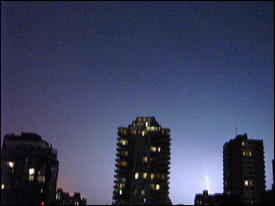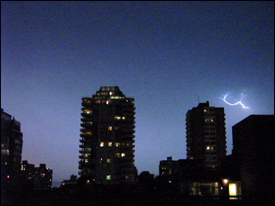july  2009
2009
 Today was the hottest day ever recorded in Vancouver. EVER. According to CBC News, a high of 33.8 degrees C/92.84 F was recorded in Vancouver this afternoon, breaking the previous record set in 1960 of 33.3 degrees C/91.94 F. And yes, it totally feels like the hottest day ever recorded. I can personally attest to the fact that most of my conversations revolved around how fucking ungodly hot it was and how — wait... no, actually, that was it. It was fucking hot. There wasn't much else to say.
Today was the hottest day ever recorded in Vancouver. EVER. According to CBC News, a high of 33.8 degrees C/92.84 F was recorded in Vancouver this afternoon, breaking the previous record set in 1960 of 33.3 degrees C/91.94 F. And yes, it totally feels like the hottest day ever recorded. I can personally attest to the fact that most of my conversations revolved around how fucking ungodly hot it was and how — wait... no, actually, that was it. It was fucking hot. There wasn't much else to say.
As an upside, the heat is causing some of the most amazing lightning storms, like the one that lasted almost two hours on Saturday night preceding a fireworks display over English Bay — which, it must be said, was thoroughly upstaged by Mother Nature. Unfortunately, the lightning storms are also causing hundreds of forest fires all over BC — then again, there have already been hundreds of forest fires this summer due to the usual causes.
We took pictures before the lightning storm started, as the entire city was shrouded in an incredible orange haze that seemed to capture everyone's attention, fixing their eyes skyward in anticipation. When the light show started, we switched to video for obvious reasons. These are a few of the still frames from the video, which Mr. Pink is working on editing as we speak. Coincidentally (or perhaps/obviously not so much), one of the latest collections of breathtaking images over at Boston.com is of lightning storms from around the world.
So, I've been thinking — albeit slowly and incoherently — that if global warming turns out to be irreversible, we'll have a lot more to worry about than just the cessation of currents in the Gulf Stream and the inundation of coastal cities and island nations. Judging by my own severely decreased mental faculties right now (e.g. my inability to spell "lightning" correctly on the first try even once), we'll have a second Dark Ages on our hands long before the rising tides have us packing up and relocating to Arizona Bay.
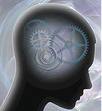 I'm formulating a theory — not a very nice one — about how our personalities develop over the course of our lives in inverse proportion to our ability and inclination to relate to other people. I think it's similar to the way that children are born with the capacity to learn any language they're exposed to; this remarkable natural affinity peaks between the ages of five and 12 as the synaptic connections associated with their primary language grow stronger, laying the foundation for the left hemisphere language center and the framework of the child's verbal identity (see the Brain from Top to Bottom).
I'm formulating a theory — not a very nice one — about how our personalities develop over the course of our lives in inverse proportion to our ability and inclination to relate to other people. I think it's similar to the way that children are born with the capacity to learn any language they're exposed to; this remarkable natural affinity peaks between the ages of five and 12 as the synaptic connections associated with their primary language grow stronger, laying the foundation for the left hemisphere language center and the framework of the child's verbal identity (see the Brain from Top to Bottom).
After that, with surprising speed and efficiency speech overtakes putting things in your mouth, as a child's first-line interaction with the outside world. Around age five or six the ability to read swiftly becomes almost involuntary while the brain's affinity for learning additional languages begins to drop off precipitously. After the age of 12, as our ability to pick up languages with ease is decimated, other areas of the brain start to undergo a similar pruning process which goes on for the rest of our lives. All those "extra" connections in the brain are allocated to more practical uses like memorizing PIN numbers and creating a mental map of the local grocery store.
If, at five years of age, we have the maximum number of brain cells and unallocated synaptic receptors that we will ever have, it could be said that this is when we are at our most malleable and "open-minded," ideologically and socially as well as linguistically. This is what makes child prodigies and child soldiers possible. Up to a certain age, a child's capacity for imprinting is almost unlimited, and examples of this abound in language, music, memorization and mass murder, depending on the child's surroundings.
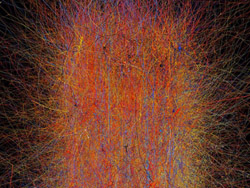 Elaborate social and cultural systems are also rapidly assimilated although, to their parents, entreaties like "say please and thank you" and "it's impolite to stare" may seem endless and without impact. The habits, preferences and prejudices imprinted on a child's brain at this stage will most likely become permanent aspects of their personality and over time these foundational beliefs will be increasingly difficult to alter.
Elaborate social and cultural systems are also rapidly assimilated although, to their parents, entreaties like "say please and thank you" and "it's impolite to stare" may seem endless and without impact. The habits, preferences and prejudices imprinted on a child's brain at this stage will most likely become permanent aspects of their personality and over time these foundational beliefs will be increasingly difficult to alter.
Ultimately, our experiences come together in a unique configuration to create the people we become; our family and friends, education, exposure to tragedy and culture and mass media; physical activity, nutrition and environmental factors as well as temperament, self-esteem, social skills and countless other factors play their parts in the development of our character. In addition, there are the unseen forces such as socioeconomic status, nationality, genetic makeup, gender, height, weight — even the era into which we are born — that can exert enormous influence.
People always say that it gets harder to make new friends or start new relationships as they get older. They complain that it was so much easier when they were kids. I used to think the explanation was simple — kids are forced to socialize with each other; at school, in the playground, in their neighborhoods and in all those "extracurricular" activities that get kids out of the house, like sports and summer camp. When you grow up and go off to work or college or both, you leave friends and family behind and narrow your field of interests to focus on establishing yourself in the world as an individual.
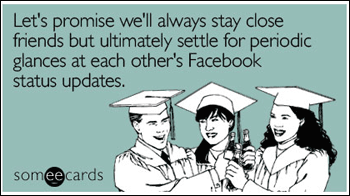 As an adult, you no longer have the time or inclination to get to know people just because you are the same age or you like the same band. You make friends with your college roommate because, duh, he's your roommate. You go out drinking with people whose common interest with you is drinking. You meet someone and fall in love, you break up, you meet someone else and so on (and on), more often than not just because they are there. In the complicated dance of rituals and pheromones, our mirror neurons and selfish genes act in their own interest, and in that of the species, just as they've done throughout the ages.
As an adult, you no longer have the time or inclination to get to know people just because you are the same age or you like the same band. You make friends with your college roommate because, duh, he's your roommate. You go out drinking with people whose common interest with you is drinking. You meet someone and fall in love, you break up, you meet someone else and so on (and on), more often than not just because they are there. In the complicated dance of rituals and pheromones, our mirror neurons and selfish genes act in their own interest, and in that of the species, just as they've done throughout the ages.
Once biology has had its way with us, we often find ourselves inhabiting ever-narrowing circles of self-interest. The greater our success at self-actualization, the more self-involved and intolerant we become.
We've all lost friends in a break-up. We've all lost touch with acquaintances after a move. We've all left a job with coworkers we "loved" and ended up never speaking to them again. You may say that these relationships were circumstantial — friendships of convenience that made those hours in the cubicle pass a bit faster, nothing more. What makes them so different from the friends you made in school?
I say it's you that's different. The things we first notice about people we meet, the common interests and biases that act as filters, may have seemed harsh and superficial in high school (dress code, musical taste, social standing) but they remain in effect, if somewhat disguised. As an adult, you may not judge someone you've just met based on his hairstyle but what if you find out he voted for Bush in 2004?
 Those deeply engrained beliefs and biases incrementally decrease your capacity to tolerate the beliefs of others and as time goes by, there are fewer and fewer to whom you can relate. As you streamline and specialize, strip away all that is not "you," focus on attaining your goals, customize your life and surround yourself with artifacts that reflect you back at you, the less space you will have in your life and your mind for the reality of other individuals.
Those deeply engrained beliefs and biases incrementally decrease your capacity to tolerate the beliefs of others and as time goes by, there are fewer and fewer to whom you can relate. As you streamline and specialize, strip away all that is not "you," focus on attaining your goals, customize your life and surround yourself with artifacts that reflect you back at you, the less space you will have in your life and your mind for the reality of other individuals.
Our brains love to sort and identify, to match like with like and to assign value and symbolic meaning to all the things we collect and all the time we spend. As our neural networks age, their rate of regeneration slows; only novel stimuli can create new connections. That which is familiar is like a well-worn path through a dark and overgrown forest. We stick to the center, our feet unknowingly retracing our steps down the path of least resistance.
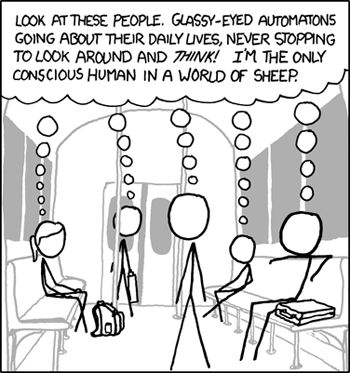 Every loss we experience, from heartbreaking breakups and tragic farewells to unrequited near-misses and all the little rejections and unchampioned offenses in between; leave their marks on us. We learn without our knowledge, instinctively understanding that the way to avoid the repetition of loss is to cauterize the severed connections.
Every loss we experience, from heartbreaking breakups and tragic farewells to unrequited near-misses and all the little rejections and unchampioned offenses in between; leave their marks on us. We learn without our knowledge, instinctively understanding that the way to avoid the repetition of loss is to cauterize the severed connections.
You know how when you were little, there were certain foods you HATED — radishes, let's say? Nothing your parents could say — just try it, it's good for you, it's an acquired taste — could prevent you from gagging and choking theatrically after trying the tiniest bite? Well, it turns out you had a perfectly good reason for acting like such a drama queen. Children's taste buds have far more powerful flavor receptors than adults'. They gradually become less and less discriminating over the course of a lifetime and their flavor-specific sensors become far less distinct.
It's the same with emotions, I think. The reason why you "never forget your first love" is that what it feels like to fall in (and out) of love is encoded as a unique pattern of neural pathways by that first overwhelming experience. How you process this maelstrom of emotions depends quite literally on the amount of damage the initial inferno of raging hormones does as it rampages through your impressionable brain. Patterns with the potential to plague us for a lifetime are also encoded in these moments; abuse and insecurity, deceit and mistrust, manipulation and self-sabotage. The only influence more potent is a parental one.
As Spock knew, the only cure for a broken heart is to "forget." We get over our first love in time but not because we make sense of those feelings and come to terms with the trauma that eventually ended it. We get over it because we meet someone else. We rewind the mix tape — the one with that song we used to play over and over thinking about the one person we knew we would love forever — we rewind it and tape over it with a new song. And in time we forget. Just like the pain of childbirth and the taste of radishes. We won't be hurt like that again, but not because we learn from our experiences. The brain's ability to respond to the stimuli of a romantic attraction, and to be devastated by its loss, is not what it used to be. The path of least resistance isn't just well-worn, it now has guardrails.
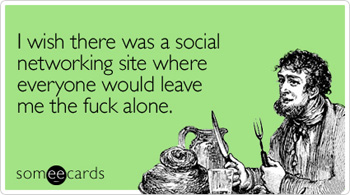 With the advent of social networking — BookedIn, LinkFace and the like — we need never lose touch again. An entire lifetime of acquaintances, from our first BFF to our most distant cousin and former coworkers from every short-lived step on the corporate ladder. We need never forget those smiling faces now that their profile pictures are permanent fixtures on our wall. And let's not forget all the exes — ours and our friends' and those ex-family members — that tangled web of digital connections may prove thicker than blood in the end.
With the advent of social networking — BookedIn, LinkFace and the like — we need never lose touch again. An entire lifetime of acquaintances, from our first BFF to our most distant cousin and former coworkers from every short-lived step on the corporate ladder. We need never forget those smiling faces now that their profile pictures are permanent fixtures on our wall. And let's not forget all the exes — ours and our friends' and those ex-family members — that tangled web of digital connections may prove thicker than blood in the end.
All those pictures and profiles represent episodes from your personal history, the phases you went through and the roles you played; all categorized and organized in neat little modules you can sort and arrange to reflect you back at you — and to the world, whatever that is. Yes, each and every one is a fragment of you — collect them all — they're yours to keep, not frozen in time and fading like our fallible memories but digitally sampled and remotely secured in the hive mind, with add-ons and subscription options compatible with your lifestyle and operating system. Now you never have to be without them; you can add them or block them, tag them, quiz them, poke them and hunt down the ones that got away. At last, secure in the knowledge that you'll never really be alone again, you can kick back in the comfort of your own life and watch all their profile pictures age and reproduce — like Sea Monkeys or the Kennedys — little stars on the world's longest-running reality show about you.
 This is what always happens. Every time I get into the topic of nuclear weapons and looking stuff up on the Internet, it's a safe bet that several days later I'll still be on this weirdo kick, inspecting fallout maps and trying to decipher some arcane data tables scanned in from a 1950s mimeograph, or calling Mr. Pink over to look at the latest "awesome" video I found depicting an atmospheric test recorded on x-ray sensitive film.
This is what always happens. Every time I get into the topic of nuclear weapons and looking stuff up on the Internet, it's a safe bet that several days later I'll still be on this weirdo kick, inspecting fallout maps and trying to decipher some arcane data tables scanned in from a 1950s mimeograph, or calling Mr. Pink over to look at the latest "awesome" video I found depicting an atmospheric test recorded on x-ray sensitive film.
Although to be fair, it's not just me. He was the one who found this diagram comparing the explosive yields from Hiroshima and the 1945 Trinity test with the world's first hydrogen bomb dropped on the Bikini Atoll and the USSR's "Tsar Bomba" — the king of all bombs.
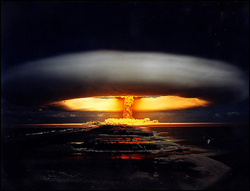 At 50,000 megatons "Ivan" as it was nicknamed, dropped October 30, 1961, was by far the largest thermonuclear weapon ever tested. Due to its very nearly unmanageable size, it was deemed impractical for military purposes but it did a fine job of scaring the living shit out of the capitalist dogs in Washington, thus setting the stage for three more decades of stockpiling in an arms race towards "mutually assured destruction."
At 50,000 megatons "Ivan" as it was nicknamed, dropped October 30, 1961, was by far the largest thermonuclear weapon ever tested. Due to its very nearly unmanageable size, it was deemed impractical for military purposes but it did a fine job of scaring the living shit out of the capitalist dogs in Washington, thus setting the stage for three more decades of stockpiling in an arms race towards "mutually assured destruction."
At the end of my previous post about Robert Oppenheimer, I mentioned that the US nuclear arsenal stood at around 25,000 at the end of the Cold War, but it didn't occur to me until today to find out how many are still "launch ready." As of early 2007, the US has 5,736 active stockpile warheads and may or may not be on the verge of an agreement with Russia to reduce both nations' arsenals even further. I feel safer already, don't you?
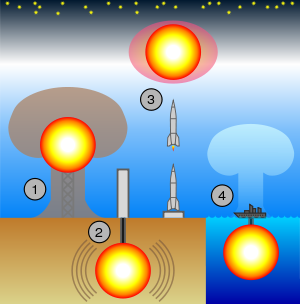 But wait... isn't there something else about nuclear weapons that makes them unsafe? By the time Superpower Number Two cried "bankruptcy" and everyone (sort of) put their toys away and went home, hadn't a handful of nuclear nations managed to test over 2,000 of the things on land, air and sea?
But wait... isn't there something else about nuclear weapons that makes them unsafe? By the time Superpower Number Two cried "bankruptcy" and everyone (sort of) put their toys away and went home, hadn't a handful of nuclear nations managed to test over 2,000 of the things on land, air and sea?
Actually, according to atomicarchive.org, it was more like 2,056. Here's a neat bar graph showing the number of tests performed per year by each country from 1945 to 1998.
When you put it that way, it does seem pretty, um — what's the word I'm looking for... fucking retarded — that the governments of the nuclear nations deemed it necessary and in the national interests of their citizens to detonate 2,056 of the things, exposing entire generations of innocent people downwind and up the food chain to unprecedented levels of cancer-causing radiation, to say nothing of the poor scientists, pilots, soldiers, sailors and miners whose jobs required them to be up close and personal and — sometimes literally — in the trenches.
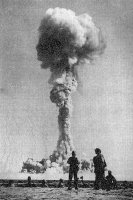 Now that the Cold War has been over for almost as long as it lasted, what have we learned about the long-term consequences of life in the atomic age?
Now that the Cold War has been over for almost as long as it lasted, what have we learned about the long-term consequences of life in the atomic age?
Well, the US passed the Radiation Exposure Compensation Act back in 1990, approving more than $1.38 billion for people suffering the effects of exposure to radiation from the Nevada Test Site and elsewhere. According to Wikipedia, as of March 2009, this makes the United States the only nation in the nuclear club to compensate its citizens for using them as unwitting test subjects.
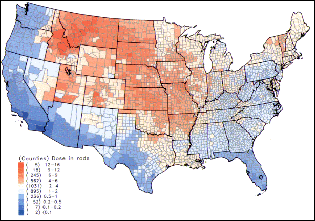 As for the rest of us, who were exposed without informed consent simply by virtue of living within 3,000 miles of the blast radius, this nuclear fallout concentration map shows the average "per capita thyroid doses resulting from all exposure routes from all atmospheric nuclear tests conducted at the Nevada Test Site from 1951 - 1962."
As for the rest of us, who were exposed without informed consent simply by virtue of living within 3,000 miles of the blast radius, this nuclear fallout concentration map shows the average "per capita thyroid doses resulting from all exposure routes from all atmospheric nuclear tests conducted at the Nevada Test Site from 1951 - 1962."
The original data, along with many more detailed maps breaking down exposure by individual test and other risk factors, can be found at the National Cancer Institute web site. Provided you were alive between 1951 and 1962, you can even find your estimated dose based on year of birth, where you lived and how much milk you drank — which matters a lot more than the Dairy Farmers Coalition would have you know. Here's how the calculations are obtained:
"The total dose resulting from a given [nuclear] test is obtained by adding the estimated mean dose from inhalation and ... from ingestion of the foodstuffs considered (cows' milk, goats' milk, mothers' milk (for infants), cottage cheese, eggs, and leafy vegetables)."
— Estimated Thyroid Doses, NCI
So, for example, my mother was born in late November 1951 in Long Beach, California. Let's say she drank an average amount of milk as a child. This map is NCI's best estimate of her exposure to Iodine-131 from birth through 1962. From the looks of this map, assuming she stayed in Long Beach (which she didn't), she could hardly have selected a safer haven from fallout if she'd tried. Of course, this map fails to take into account the other factors that made her migration northward just as well.
Ah, the fifties... what a decade. The optimism, the ignorance, the cone-shaped bras. Just think how far we've come. It makes you wonder what they would have thought if they'd been given a glimpse of what the future would really be like...
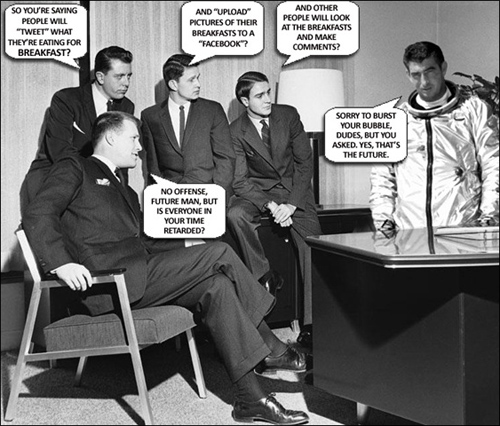
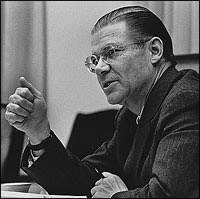 Former Secretary of Defense and "Architect of the Vietnam War" Robert S. McNamara died this week at the age of 93. I wish him luck in his next incarnation — or whatever form the afterlife takes for him — and hope that cosmic justice is light years more evolved than human justice because he has a lot of souls to answer to.
Former Secretary of Defense and "Architect of the Vietnam War" Robert S. McNamara died this week at the age of 93. I wish him luck in his next incarnation — or whatever form the afterlife takes for him — and hope that cosmic justice is light years more evolved than human justice because he has a lot of souls to answer to.
It always intrigues me when someone like McNamara lives to a ripe old age like 93, haunted by the consequences of being extraordinarily successful at the very worst things a person can do. What set him apart from men like Augusto Pinochet and Charlton Heston is that in the end — for the last few decades of his life in fact — he engaged in a process of acknowledging to himself and to the world that he was responsible for some truly horrible, unforgivable things.
"I was on the island of Guam... in March of 1945. In that single night, we burned to death 100,000 Japanese civilians in Tokyo: men, women, and children... I was part of a mechanism that in a sense recommended it. I analyzed bombing operations, and how to make them more efficient.
[General Curtis] LeMay said, "If we'd lost the war, we'd all have been prosecuted as war criminals." And I think he's right. He, and I'd say I, were behaving as war criminals. LeMay recognized that what he was doing would be thought immoral if his side had lost. But what makes it immoral if you lose and not immoral if you win?" — Robert S. McNamara, Fog of War (full transcript here)
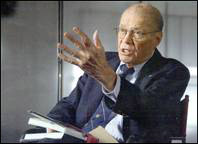 Watching as he reflects on his life in Errol Morris' Fog of War, you can see all those memories and emotions trying to surface; regret, despair and shame dance across his face, periodically snatching the spotlight from his dominant persona. He still had his pride and convictions but he was tired of the constant struggle to keep the darkness and doubts under control. He was taking an intellectual approach to the problem, confronting and assimilating what he could in the hopes of achieving some sort of redemption.
Watching as he reflects on his life in Errol Morris' Fog of War, you can see all those memories and emotions trying to surface; regret, despair and shame dance across his face, periodically snatching the spotlight from his dominant persona. He still had his pride and convictions but he was tired of the constant struggle to keep the darkness and doubts under control. He was taking an intellectual approach to the problem, confronting and assimilating what he could in the hopes of achieving some sort of redemption.
This was the unending war he lived with, and in the end you feel an eerie certainty that you've witnessed a man at the end of his life confront himself and surrender. Errol Morris' masterful hand as interviewer and editor cannot be overlooked — it is at those times when he allows his voice to be heard asking questions of his subject, pressing him on certain issues, that we glimpse the true nature of this inner conflict.
I'll admit it's disturbing to hear this man who was once referred to as "an IBM machine with legs" reeling off half a dozen cities in Japan and the percentage of their population killed by American bombers during WWII, then naming an American city of analogous size from memory, just like a god damned computer — "58% of Yokohama. Yokohama is roughly the size of Cleveland. 58% of Cleveland destroyed. Tokyo is roughly the size of New York. 51% of New York destroyed" and so on (I was reading that passage in the transcript not five minutes ago and I couldn't remember a single number just now without checking it again). But what's more disturbing and what ultimately makes the documentary so deserving of its Oscar and all the praise it's received, is that McNamara is so undeniably engaging; at 85, his wit and intellect are as sharp as ever, his memory clearer than that of most men half his age. He comes across as a charismatic if not outright likeable character.
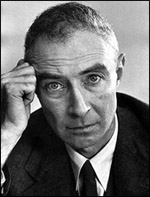 Here is an interesting contrast. J. Robert Oppenheimer, the "Father of the Atom Bomb," was another man whose legacy is forever intertwined with the history of modern warfare and the killing of civilians on a massive scale. It hardly seems fair when you consider how his contemporaries — Albert Einstein, Enrico Fermi and even the youngest member of the Los Alamos gang, Richard Feynman — are remembered; they are physicists (maybe geniuses) first, architects of mass destruction a distant second. Among his fellow Manhattan Project alumni, only Edward Teller, the "Father of the Hydrogen Bomb," casts a darker shadow in the distorted looking glass of history.
Here is an interesting contrast. J. Robert Oppenheimer, the "Father of the Atom Bomb," was another man whose legacy is forever intertwined with the history of modern warfare and the killing of civilians on a massive scale. It hardly seems fair when you consider how his contemporaries — Albert Einstein, Enrico Fermi and even the youngest member of the Los Alamos gang, Richard Feynman — are remembered; they are physicists (maybe geniuses) first, architects of mass destruction a distant second. Among his fellow Manhattan Project alumni, only Edward Teller, the "Father of the Hydrogen Bomb," casts a darker shadow in the distorted looking glass of history.
I just finished watching the critically acclaimed BBC miniseries "Oppenheimer" which originally aired in 1980 and was recently released on DVD. What made the prospect of watching this 7-hour made for TV biopic irresistible, aside from the simple fact that I hadn't seen it yet, is that Oppenheimer is played by Sam Waterston, for whom I have an abiding affection. It started with Law & Order, quite likely during his performance in a certain courtroom scene involving a shoe box full of bullets. My fondness for him has grown steadily ever since, especially after I finally saw The Killing Fields (for which he won an Oscar) and heard his voice over so many documentaries I've enjoyed. Here's a bit of IMDB trivia; in addition to his frequent roles as District Attorneys, Sam Waterston has played two fictional US Presidents and three real Presidents on four different occasions (Abraham Lincoln twice).
 The miniseries gives a fantastically detailed account of the events leading up to the invention of the atomic bomb and its aftermath as well as the subsequent development of the hydrogen bomb, which was spearheaded by Edward Teller. Probably because it was produced by the BBC, the story is told from a decidedly scientific perspective. It focuses closely on the project's unprecedented assembly of scientists and chronicles in detail the challenges, conflicts and collaborations that took place between them.
The miniseries gives a fantastically detailed account of the events leading up to the invention of the atomic bomb and its aftermath as well as the subsequent development of the hydrogen bomb, which was spearheaded by Edward Teller. Probably because it was produced by the BBC, the story is told from a decidedly scientific perspective. It focuses closely on the project's unprecedented assembly of scientists and chronicles in detail the challenges, conflicts and collaborations that took place between them.
Sam Waterston's performance is astounding — and when I watched the interview included on the DVD, a conversation between Edward R. Murrow and the real Oppenheimer in 1955, I was even more astounded. Waterston became Oppenheimer.
More than that, though, I was struck by the fact that it was impossible to think about civilian casualties on a massive scale while watching this softspoken, elegant man, his eyes sparkling with laughter. His face would often come to rest in a wide, gentle grin when he paused between profound philosophical musings; as he spoke about his scientific pursuits, his long, graceful hands would flutter around excitedly, then he would tuck them boyishly between his knees as he stopped to listen and consider what he would say next.
 Oppenheimer died at the age of 62 (of cancer, what else?), outlived by more than 30 years by McNamara, but when you compare these two men who both undeniably had "blood on their hands," as Oppenheimer once said to Truman, you come away with the overwhelming impression that one used his extra time to bargain for his soul while the other was able to finally make peace with the part he played in the history of war.
Oppenheimer died at the age of 62 (of cancer, what else?), outlived by more than 30 years by McNamara, but when you compare these two men who both undeniably had "blood on their hands," as Oppenheimer once said to Truman, you come away with the overwhelming impression that one used his extra time to bargain for his soul while the other was able to finally make peace with the part he played in the history of war.
"We knew the world would not be the same. A few people laughed, a few people cried, most people were silent. I remembered the line from the Hindu scripture, the Bhagavad-Gita. Vishnu is trying to persuade the Prince that he should do his duty and to impress him takes on his multi-armed form and says, "Now I am become Death, the destroyer of worlds." I suppose we all thought that, one way or another." — Robert Oppenheimer in 1965, speaking about the Trinity test
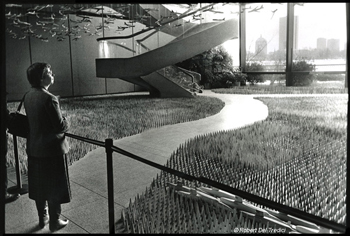 At left: Amber Waves of Grain by Barbara Donachy, Boston Science Museum installation, February 1985. "This field of ceramic nose cones represents, in miniature, all the warheads in the U.S. nuclear arsenal by the end of the Cold War. Estimates set that total at 25,000."
At left: Amber Waves of Grain by Barbara Donachy, Boston Science Museum installation, February 1985. "This field of ceramic nose cones represents, in miniature, all the warheads in the U.S. nuclear arsenal by the end of the Cold War. Estimates set that total at 25,000."
